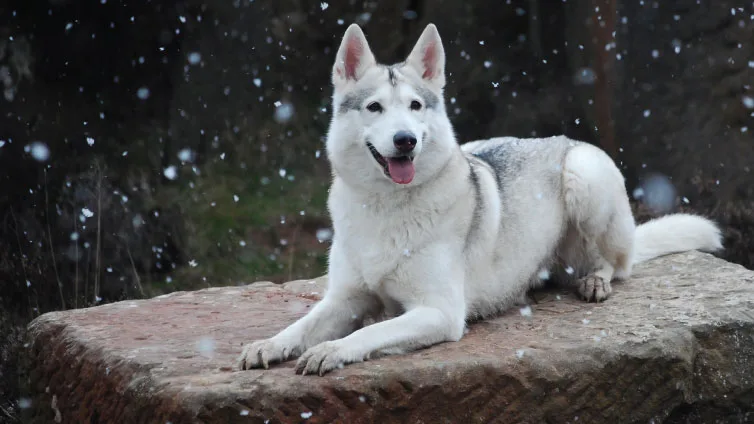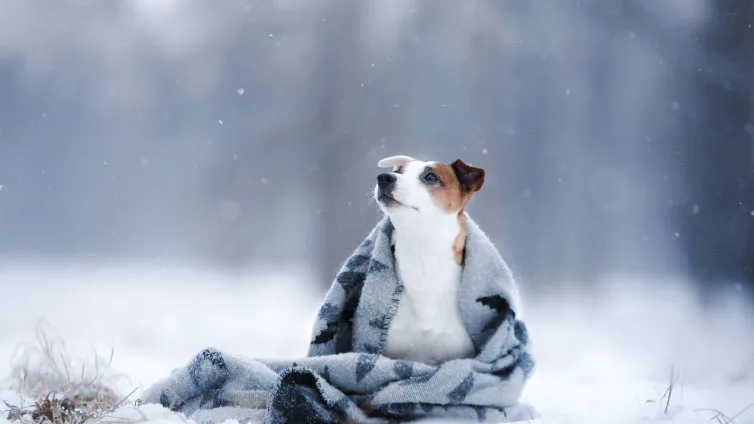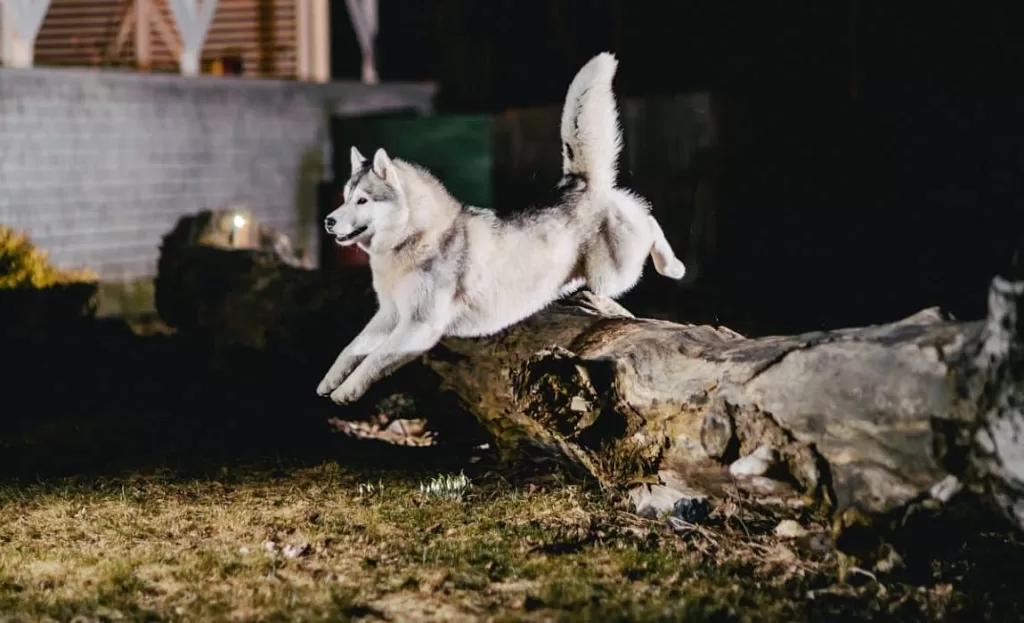Do dogs get cold at night? During the cold winter months, many pet owners wonder if their furry friends can stay warm enough at night. While humans can easily throw on a coat and a pair of socks to stay warm, it’s not so easy for our canine companions.
Table of Contents
Fortunately, there are steps we can take to keep our beloved pets from suffering from the cold. Read on to learn more about how to keep your puppy warm at night.
So, Do dogs get cold at night?

As dog owners, it’s important to understand how the cold can affect our furry friends. We often think about how cold weather affects our own comfort, but what about our canine companions? Do dogs get cold at night?
The short answer is yes. Dogs get cold at night, just like humans. However, it is important to look at the specific breed of dog and their individual needs as to how much cold they can handle. There are various factors that can predispose a dog to a cold.
- For starters, a dog’s coat is the first line of defense against the cold. Thin-coated breeds or shaved breeds are more likely to experience the effects of cold. It’s also important to remember that not all dogs like being outdoors in cold weather. Species with a natural tendency to stay indoors are more likely to be affected by the cold if they are outside for long periods of time.
- Another factor to consider is the dog’s age. Puppies and older dogs are more susceptible to the cold due to their naturally thin skin and lack of fur. This makes them more susceptible to the effects of cold temperatures.
- Finally, it’s important to assess your dog’s overall health. Dogs with malnutrition or underlying medical conditions may experience the effects of the cold more.
When it comes to protecting your dog from the cold, the most important thing is to provide them with adequate shelter. This includes a doghouse or a warm and dry place indoors. It’s also important to make sure your dog has plenty of food and water available to keep him warm and hydrated.
5 Dog Breeds Who Better Tolerate The Cold
When it comes to cold weather, not all dogs are created equal. Some species are more suited to living in colder climates, while others may find the cold uncomfortable and painful. If you live in a cold climate, it’s important to know which species are best for those conditions. Here are 5 dog breeds that tolerate the cold well.
- Siberian Husky: Siberian Huskies have been bred for generations to withstand cold temperatures. Their thick double-layered coats are designed to keep them warm even in the coldest conditions. Their thick fur helps protect their skin from snow or ice.
- Alaskan Malamute: This is another breed bred to withstand cold temperatures. Like the Siberian Husky, they have double-layered coats designed to keep them warm even in very cold weather.
- Saint Bernard: These large dogs are designed to work in snow and ice and can withstand colder temperatures than other breeds. Their thick coats and large size provide extra insulation in cold weather.
- Samoyed: These fluffy white dogs are well-equipped to handle cold temperatures. Their thick fur helps keep them warm and their double-layered coats help protect them from the cold.
- Newfoundland: This large breed is well suited to cold climates. They have a thick double coat that helps keep them warm, and their webbed feet make them excellent swimmers that can handle snow and ice.
These are just a few of the dog breeds that are best suited to colder temperatures. Regardless of the breed you choose, make sure your pup has plenty of extra layers when the temperature drops. If you are unsure of the climate where you live, it is best to speak to your vet for advice on the best breed for your home.
Do Dogs Like To Be Warm At Night?

Do dogs like to stay warm at night? The answer to this question depends largely on the breed and the individual dog. Generally speaking, most dogs prefer warm weather in the evening and at night, especially during the cooler months of the year.
For example, some dogs, such as Chihuahuas and Pomeranians, naturally purr to stay warm in the evening and at night. They may even try to cover you or a blanket to keep warm. Other small breeds like Miniature Poodles and Shih Tzus are known for their thick fur coats that help keep them warm even when the temperatures outside drop.
Meanwhile, larger breeds like Labrador retrievers and German shepherds have a thicker layer of fat and fur under their skin that helps them stay warm during the evening and night. That’s why these dog breeds don’t need a sweater or extra clothing in the evenings, even though the temperatures are often low.
Also Read: Why Is My Dog’s Tongue Turning Purple?
It’s also important to remember that most dogs need access to a warm bed or blanket to rest comfortably at night. If your dog doesn’t have access to a warm bed, you can buy him a heated dog bed or keep him warm using a hot water bottle or electric blanket. You can also buy special sweaters or jackets for your dog in winter to help keep your dog warm.
In conclusion, most dogs prefer warm weather during the evening and night hours, especially during the cooler months of the year. However, each dog’s individual needs and preferences must be considered when trying to determine how warm each dog should be at night. Finally, providing your dog with a warm bed or blanket and, if necessary, a sweater or jacket should help keep them warm and comfortable at night.
How Warm Do Dogs Need To Be At Night?
We all want our precious babies to be snug and cozy at night, and sometimes even more so during the cold winter months. But how warm should dogs be at night? There are many factors to consider when determining the right temperature for your puppy.
Age of dog
A dog’s age plays an important role in determining how warm they need to be at night. Both puppies and senior dogs are more likely to experience cold than adult dogs. Puppies are very sensitive, so they should be kept in a warm room or covered with a blanket to keep them warm. Senior dogs may also need an extra layer of warmth.
dog breed
A dog’s breed also affects how much warmth they need at night. Certain breeds, such as Greyhounds, Chihuahuas, and Chinese Cresteds, have thinner coats and are more prone to feeling cold. Thick-coated breeds like Huskies and Malamutes are better suited to the cold. In any case, it’s best to provide extra warmth regardless of your puppy’s breed.
The health condition of the dog
When determining a dog’s nighttime temperature, its health status should also be taken into account. A sick or arthritic dog is more likely to feel cold and will need extra warmth as a result. It is important to monitor their behavior to make sure they are comfortable.
Indoor or outdoor
It is important to consider whether the dog is indoors or outdoors at night. Dogs that are kept indoors are likely to need extra warmth, while those that spend their nights outdoors may need the cold to stay alert and ready to respond to any potential danger.
The dog is adapted to cold climates
Finally, the dog’s habituation to cold climates must be considered. If the puppy is used to the cold, he or she does not need extra warmth. But if the puppy isn’t used to the cold, he or she may need more warmth.
Overall, the temperature you should keep your puppy at night depends on a number of factors, including age, breed, health condition, whether the puppy is indoors or outdoors, and if the puppy is acclimated to colder climates. In any case, it is important to keep an eye on their behavior and provide extra warmth for extra comfort.
How Do I Know If My Dog Is suffering from Cold At Night?
Cold weather can be hard on your dog, and it can be hard on you. Just like humans, dogs also become cold when the weather turns cold, which can lead to discomfort and illness. Knowing the signs of a cold in your dog can help you take steps to keep your pup healthy and comfortable.
If your dog is shivering, especially at night, this could be a sign of a cold. Dogs have a natural instinct to want to stay warm, and shivering is a sign that your pup is feeling cold. Other signs of a cold in your dog may include a wet nose, sneezing or coughing, loss of appetite, and lack of energy or activity.
One of the most important steps you can take to keep your dog healthy and comfortable in cold weather is to make sure it has access to a warm place to sleep. If your puppy is not allowed to sleep indoors, be sure to provide a warm, dry place to sleep outside that is protected from the elements. For example, a doghouse provides warmth and protection from the cold.
Additionally, if you notice that your pup is feeling cold, you can provide them with extra warmth in the form of a sweater or coat. These items will help keep your pup warm and comfortable on cold nights.
Finally, if you suspect your puppy has a cold, be sure to take them to the vet as soon as possible. The vet may offer medications or other treatments to help your puppy feel better.
It’s important to know the signs of a cold in your dog. Doing so will help you take steps to keep your pup comfortable and healthy in cold weather. Pay attention to your puppy’s behavior and make sure he is warm and dry to sleep in the cold. If you notice any signs of a cold, take your puppy to the vet for an exam.

